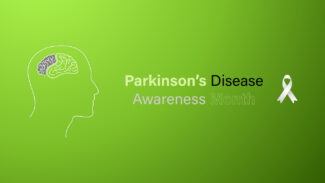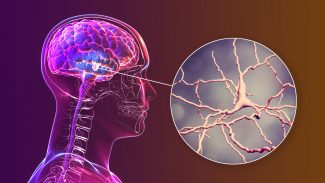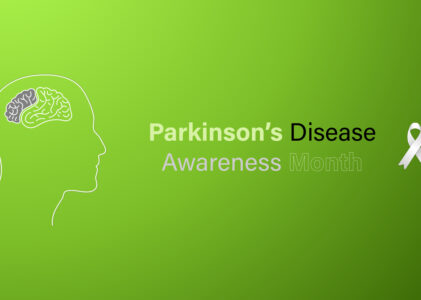
April marks Parkinson’s Awareness Month, a time dedicated to raising awareness about Parkinson’s disease (PD), its challenges, and the resources available for patients, caregivers, and medical professionals. Parkinson’s is a progressive neurodegenerative disorder that affects millions of people worldwide, disrupting their daily lives and creating hurdles for families and communities.
Early Diagnosis of Parkinson’s Disease Helps Patients
Parkinson’s disease affects approximately one million individuals in the United States, with around 60,000 new cases diagnosed each year. This progressive neurological disorder is characterized by a gradual worsening of motor and non-motor symptoms over time. The prognosis for those living with Parkinson’s varies widely, with some experiencing a slower progression and others facing more rapid declines. Early detection can significantly improve the quality of life for individuals with Parkinson’s, as it allows for earlier intervention with treatments and lifestyle modifications that can manage symptoms and potentially slow disease progression.
What is Parkinson’s Disease?
Parkinson’s disease is a chronic neurological disorder caused by the progressive loss of dopamine-producing neurons in the brain. Dopamine is crucial for regulating movement, and its depletion leads to symptoms such as tremors, stiffness, slowness of movement, and balance issues. Over time, these symptoms worsen, making everyday activities increasingly difficult. While the exact cause of Parkinson’s is still unknown, genetic and environmental factors are thought to play a role.

The exact cause of Parkinson’s disease remains a subject of ongoing research, with genetic and environmental factors both thought to contribute to its development. Studies have shown that individuals with a family history of Parkinson’s have a higher risk of developing the disease, particularly if specific genetic mutations are present. For instance, mutations in genes such as LRRK2, SNCA, and GBA have been linked to an increased risk of Parkinson’s.
In addition to genetics, environmental factors may also play a role. Exposure to certain toxins, pesticides, and heavy metals has been associated with an elevated risk of Parkinson’s. For example, individuals who work in agricultural or industrial settings where they are exposed to chemicals like paraquat or manganese may have a higher likelihood of developing Parkinson’s. Additionally, factors such as head injuries and long-term oxidative stress are also believed to contribute to the degeneration of dopamine-producing neurons in the brain, which leads to Parkinson’s symptoms.
Despite these associations, the interplay between genetic and environmental factors is complex, and more research is needed to fully understand how these influences combine to contribute to the development of Parkinson’s disease.
Symptoms of Parkinson’s Disease
The symptoms of Parkinson’s disease can vary widely, both in type and severity. The primary motor symptoms include:
- Tremors: Involuntary shaking or trembling, often starting in the hands or fingers.
- Bradykinesia: Slowed movement, making routine tasks like buttoning a shirt or walking challenging.
- Rigidity: Muscle stiffness, limiting range of motion and causing discomfort.
- Postural instability: Balance problems, increasing the risk of falls.
Non-motor symptoms also frequently accompany Parkinson’s, including:
- Cognitive decline: Memory problems, difficulty concentrating, and in some cases, dementia.
- Mood disorders: Depression, anxiety, and apathy.
- Sleep disturbances: Insomnia, vivid dreams, and other sleep-related issues.
- Autonomic dysfunction: Digestive problems, changes in blood pressure, and sexual dysfunction.
Treatment and Care for Parkinson’s Disease
While there’s currently no cure for Parkinson’s, various treatments can help manage symptoms and improve quality of life:
- Medications: Dopaminergic drugs like levodopa and dopamine agonists can mitigate motor symptoms by replenishing or mimicking dopamine.
- Surgical interventions: Deep brain stimulation (DBS) involves implanting electrodes in specific brain regions, providing electrical stimulation to reduce motor symptoms.
- Physical therapy: Movement therapies, like physiotherapy and occupational therapy, can help patients maintain mobility, balance, and independence.
- Lifestyle modifications: Regular exercise, balanced nutrition, and stress management can play a vital role in slowing symptom progression and enhancing overall well-being.
Resources for Those Affected with Parkinson’s Disease
Support is crucial for those living with Parkinson’s and their families. Fortunately, numerous organizations provide valuable resources and services:
– The Parkinson’s Foundation Helpline offers support and information for anyone impacted by Parkinson’s disease.
– The Newly Diagnosed Guide from the Parkinson’s Foundation provides comprehensive information for patients who are newly diagnosed, helping them navigate the initial stages of their journey.
– The Michael J. Fox Foundation is dedicated to finding a cure for Parkinson’s through research funding and patient support initiatives.
Parkinson’s Awareness Month provides an opportunity to shine a light on the struggles faced by those living with Parkinson’s and their families, while also celebrating the strength and resilience of the community. It’s a chance to educate, advocate, and support research for a cure.
Consider Greater Waterbury Imaging Center for all your MR imaging needs, including diagnosing Parkinson’s disease. Our team of MR technologists is dedicated to providing quality imaging services, ensuring accurate diagnoses and comprehensive care. Contact us for all your imaging needs and neurological MRI services.


